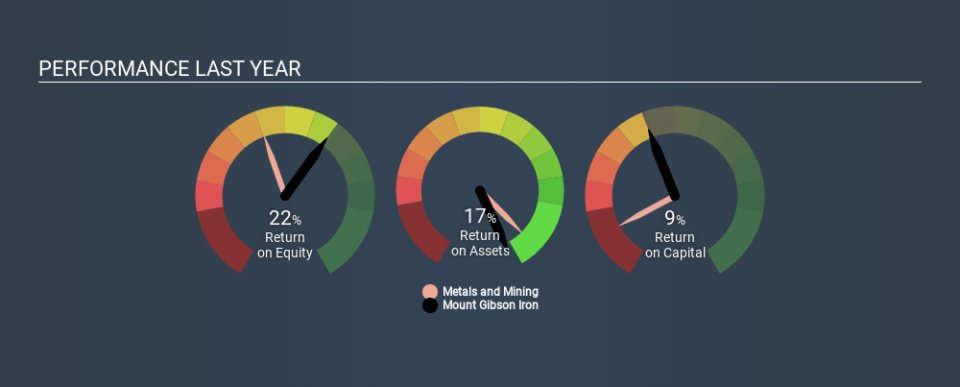Do You Know About Mount Gibson Iron Limited’s (ASX:MGX) ROCE?

Today we'll evaluate Mount Gibson Iron Limited (ASX:MGX) to determine whether it could have potential as an investment idea. In particular, we'll consider its Return On Capital Employed (ROCE), as that can give us insight into how profitably the company is able to employ capital in its business.
First, we'll go over how we calculate ROCE. Then we'll compare its ROCE to similar companies. Finally, we'll look at how its current liabilities affect its ROCE.
Understanding Return On Capital Employed (ROCE)
ROCE measures the 'return' (pre-tax profit) a company generates from capital employed in its business. All else being equal, a better business will have a higher ROCE. Ultimately, it is a useful but imperfect metric. Author Edwin Whiting says to be careful when comparing the ROCE of different businesses, since 'No two businesses are exactly alike.
How Do You Calculate Return On Capital Employed?
Analysts use this formula to calculate return on capital employed:
Return on Capital Employed = Earnings Before Interest and Tax (EBIT) ÷ (Total Assets - Current Liabilities)
Or for Mount Gibson Iron:
0.094 = AU$62m ÷ (AU$729m - AU$73m) (Based on the trailing twelve months to June 2019.)
So, Mount Gibson Iron has an ROCE of 9.4%.
View our latest analysis for Mount Gibson Iron
Does Mount Gibson Iron Have A Good ROCE?
One way to assess ROCE is to compare similar companies. Using our data, Mount Gibson Iron's ROCE appears to be around the 8.0% average of the Metals and Mining industry. Separate from Mount Gibson Iron's performance relative to its industry, its ROCE in absolute terms looks satisfactory, and it may be worth researching in more depth.
Mount Gibson Iron reported an ROCE of 9.4% -- better than 3 years ago, when the company didn't make a profit. That suggests the business has returned to profitability. The image below shows how Mount Gibson Iron's ROCE compares to its industry, and you can click it to see more detail on its past growth.
Remember that this metric is backwards looking - it shows what has happened in the past, and does not accurately predict the future. ROCE can be deceptive for cyclical businesses, as returns can look incredible in boom times, and terribly low in downturns. This is because ROCE only looks at one year, instead of considering returns across a whole cycle. Remember that most companies like Mount Gibson Iron are cyclical businesses. Future performance is what matters, and you can see analyst predictions in our free report on analyst forecasts for the company.
Do Mount Gibson Iron's Current Liabilities Skew Its ROCE?
Current liabilities include invoices, such as supplier payments, short-term debt, or a tax bill, that need to be paid within 12 months. The ROCE equation subtracts current liabilities from capital employed, so a company with a lot of current liabilities appears to have less capital employed, and a higher ROCE than otherwise. To counter this, investors can check if a company has high current liabilities relative to total assets.
Mount Gibson Iron has current liabilities of AU$73m and total assets of AU$729m. Therefore its current liabilities are equivalent to approximately 10% of its total assets. A fairly low level of current liabilities is not influencing the ROCE too much.
The Bottom Line On Mount Gibson Iron's ROCE
This is good to see, and with a sound ROCE, Mount Gibson Iron could be worth a closer look. Mount Gibson Iron shapes up well under this analysis, but it is far from the only business delivering excellent numbers . You might also want to check this free collection of companies delivering excellent earnings growth.
If you like to buy stocks alongside management, then you might just love this free list of companies. (Hint: insiders have been buying them).
If you spot an error that warrants correction, please contact the editor at editorial-team@simplywallst.com. This article by Simply Wall St is general in nature. It does not constitute a recommendation to buy or sell any stock, and does not take account of your objectives, or your financial situation. Simply Wall St has no position in the stocks mentioned.
We aim to bring you long-term focused research analysis driven by fundamental data. Note that our analysis may not factor in the latest price-sensitive company announcements or qualitative material. Thank you for reading.

